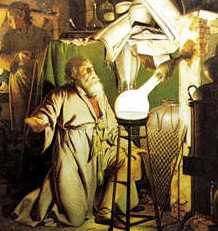| << Chapter < Page | Chapter >> Page > |
The Group 15 elements have a particular name pnictogens . Despite the modern IUPAC notation, the Group 15 elements are still referred to as Group V elements in particular by the semiconductor industry. [link] lists the derivation of the names of the Group 15 elements.
| Element | Symbol | Name |
| Nitrogen | N | Latin nitrogenium , where nitrum (derived from Greek nitron) means saltpetre |
| Phosphorus | P | From the Greek phosphoros meaning bringer of light |
| Arsenic | As | Derived from Syriac zarniqa and Persian zarnikh , meaning yellow orpiment |
| Antimony | Sb | Greek anti and monos meaning not alone . The symbol Sb from Latin stibium |
| Bismuth | Bi | New Latin bisemutum from German Wismuth , meaning white mass |
Nitrogen was discovered by Rutherford ( [link] ) in 1772. He called it noxious air or fixed air because there it had been known since the late 18 th century that there was a fraction of air that did not support combustion. Nitrogen was also studied by Scheele ( [link] ), Cavendish ( [link] ), and Priestley ( [link] ), who referred to it as burnt air or phlogisticated air .




German alchemist Hennig Brand ( [link] ) was experimenting with urine (which contains dissolved phosphates) in 1669. While attempting to create the fabled philosopher's stone (the legendary alchemical substance capable of turning base metals, such as lead, into gold) by the distillation of salts from urine, he produced a white material that glowed in the dark and burned with a brilliant light. He gave the substance the name phosphorus mirabilis ( miraculous bearer of light ). His process involved letting the urine stand for days then boiling it down to a paste which led to a white waxy substance, white phosphorus.

Brand sold the recipe for 200 thaler (a silver coin from whose name the dollar is derived) to D Krafft who toured much of Europe showing it. During his journeys he met Robert Boyle ( [link] ) who without learning the details of the synthesis recreated and improved it by using sand in the reduction of the phosphate, [link] .

Notification Switch
Would you like to follow the 'Chemistry of the main group elements' conversation and receive update notifications?